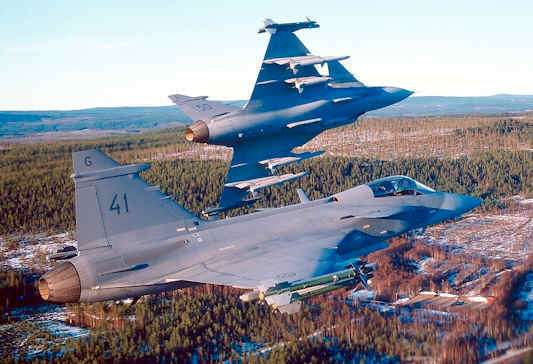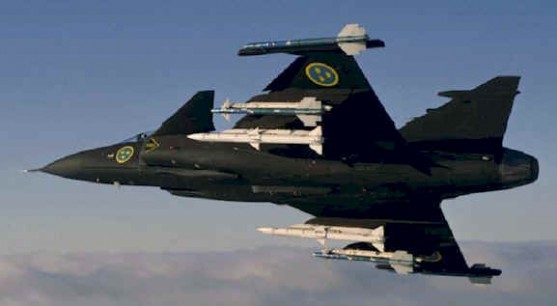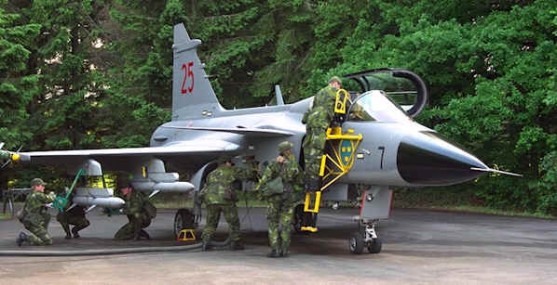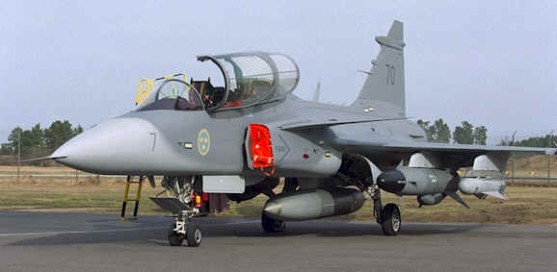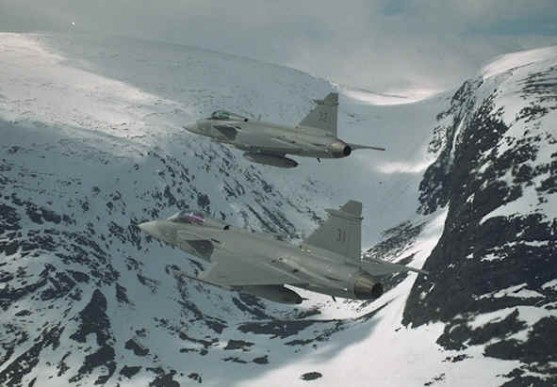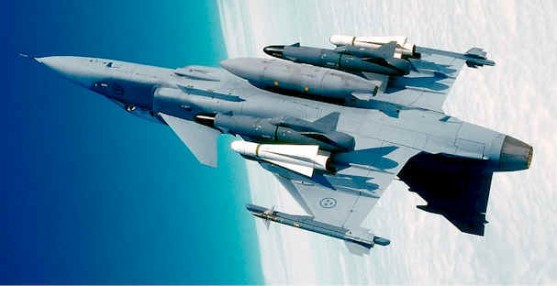10th Anniversary of first flight
by Fredrik Zetterberg, Euroavia Stockholm
Photos courtesy of SAAB Aerospace
Enlish version, see below !
![]() Klockan 12.22, den nionde september 1988, lyfte den första prototypen till JAS39 Gripen för första gången. JAS39 Gripen är det första flygplanet ur den fjärde generationen i tjänst. Dessutom är det enda lättvikts- och flerrolls-flygplanet i den generationen än så länge.
Klockan 12.22, den nionde september 1988, lyfte den första prototypen till JAS39 Gripen för första gången. JAS39 Gripen är det första flygplanet ur den fjärde generationen i tjänst. Dessutom är det enda lättvikts- och flerrolls-flygplanet i den generationen än så länge.
Bakgrund
Gripen är ett flygplan som egentligen aldrig skulle ha existerat. Flygvapnet sökte under slutet av 70-talet framförallt efter ett nytt attackflygplan som skulle kunna ersätta de AJ37 Viggen, som då precis hade kommit i tjänst. Jaktversionen av Viggen, JA37, hade inte ens gjort sin första flygning än men hade blivit en halv generation yngre än attackflygplanet det utvecklats ifrån. Bland annat hade man utvecklat motorn och försett JA37 med ny avionik och ny radar. Man trodde därför att JA37 skulle kunna leva betydligt längre än sina föregångare och kanske vara i tjänst under närmare 30 år. Man kunde även vidareutveckla den till ett nytt attackflygplan, A20. Vad flygvapnet framförallt ville ha var en skolflygplan, tillika ett lätt attackplan. Saab besvarade behovet med ett projekt kallat B3LA, ett enmotorigt underljudsflygplan.
Tyvärr lades B3LA ner tidigt på våren 1979, tillsammans med 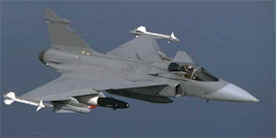 alla andra projekt. Detta var givetvis ett stort avbräck för flygvapnet såväl som industrin. Saab visste mycket väl att dess vara eller icke vara mer eller mindre hängde på ett nytt militärt projekt. Inom flygvapnet trodde man att man skulle få problem att hålla sina Viggar och Drakar i luften utan en stark industri som kunde underhålla dem. De flesta politiker accepterade detta synsätt och redan i april 1979 fick överbefälhavaren instruktioner att börja studera en möjlig ersättare till Viggen.
alla andra projekt. Detta var givetvis ett stort avbräck för flygvapnet såväl som industrin. Saab visste mycket väl att dess vara eller icke vara mer eller mindre hängde på ett nytt militärt projekt. Inom flygvapnet trodde man att man skulle få problem att hålla sina Viggar och Drakar i luften utan en stark industri som kunde underhålla dem. De flesta politiker accepterade detta synsätt och redan i april 1979 fick överbefälhavaren instruktioner att börja studera en möjlig ersättare till Viggen.
Väldigt snart stod det klart att det nya flygplanet skulle behöva vara billigt. Eftersom storlek och pris har ett nästintill linjärt förhållande var det lika uppenbart att det nya flygplanet skulle vara ett lättviktsflygplan. Det var vidare tvunget att ersätta samtliga versioner av Viggen, likaväl som de få kvarvarande Drakarna. Det betydde att det skulle bli ett flerrollsflygplan, ett JAS. JAS står för övrigt för Jakt, Attack och Spaning.
Under mitten av 70-talet hade möjligheterna att bygga ett sådant flygplan, med flerrollskapacitet och låg vikt, studerats. Man hade dock konstaterat att det krävde teknik som ännu inte var utvecklad. Viss grundläggande forskning hade dock gjorts i samband med utvecklandet av B3LA vilket skulle göra utvecklandet av det nya flygplanet lättare. Bland annat hade man gjort motor- och kompositstrukturstudier.
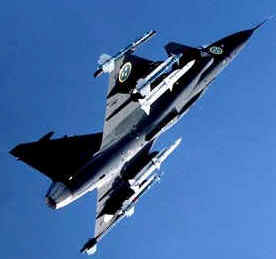 Det var visserligen långt ifrån säkert att det nya flygplanet skulle bli svenskt. USA hade under 70-talet utvecklat nya flygplan för såväl flygvapen som flotta som skulle passa det svenska flygvapnet. Tidigt på sommaren 1980 inbjöds ett antal utländska tillverkare att lämna offert på sina flygplan. De tre tillverkare som lämnade offerter i april 1981 var General Dynamics med F-16 Fighting Falcon, McDonnell Douglas med F/A-18 Hornet och Northrop med F-20 Tigershark.
Det var visserligen långt ifrån säkert att det nya flygplanet skulle bli svenskt. USA hade under 70-talet utvecklat nya flygplan för såväl flygvapen som flotta som skulle passa det svenska flygvapnet. Tidigt på sommaren 1980 inbjöds ett antal utländska tillverkare att lämna offert på sina flygplan. De tre tillverkare som lämnade offerter i april 1981 var General Dynamics med F-16 Fighting Falcon, McDonnell Douglas med F/A-18 Hornet och Northrop med F-20 Tigershark.
För att möta detta hot bildade Saab-Scania, Volvo Flygmotor, Ericsson och FFV Aerotech ett gemensamt bolag, Industrigruppen JAS. IG JAS lämnade sin offert i juni 1981. Av de amerikanska flygplanen ansågs F/A-18 Hornet vara bäst lämpat för att konkurrera mot det svenska JAS. Till slut bedömdes dock det inhemska alternativet vara såväl bäst som billigast. 30 juni 1982 skrevs så ett avtal under angående utveckling av det nya flygplanet. Dessutom beställde Försvarets Materielverk 30 flygplan i en fösta delserie. Kontraktet fick senare stor kritik då villkoren i det till stor del bidrog till problemen senare i utvecklingen.
Utvecklingen
Svensk industri hade nu mycket höga krav ställda på sig. Saab skulle utveckla ett flygplan som vägde 60% av Viggen, ändå kapabel att bära samma vapenlast och vara fullt modernt i mer än 30 års tjänst. Volvo Flygmotor skulle utveckla, på basis av en existerande motor, en motor som skulle passa de speciella krav som ställdes av flygvapnet och det svenska klimatet. Ericsson skulle bli först i världen med att utveckla en radar som kunde hantera och växla mellan jakt-, attack- och spaningsuppdrag utan andra åtgärder än en knapptryckning. FFV Aerotech skulle se till att flygplanet var enkelt att underhålla. Alla företagen hade verkligen svåra uppgifter!
För Saabs del fans det en hel del självklara beslut att fatta. Först och främst, flygplanet var tvunget att vara utrustat med ett elektriskt styrsystem. Detta var nödvändigt eftersom flygplanet var tvunget att byggas statiskt instabilt för att få 9G-prestanda. Dessutom skulle Saab använda en hel del kompositmaterial i flygplanet. Många system skulle köpas färdiga från utlandet eftersom detta skulle bli mycket billigare än att utveckla dem i Sverige. Till exempel har Saab alltid utvecklat egna räddningssystem, men i Gripen sitter en raketstol från engelska Martin-Baker.
Volvo hade tre olika motorer att välja mellan. Europeiska samarbetsprojektet Rb199, som sitter i Panavia Tornado, Pratt & Whitney PW1120, en icke färdigutvecklad motor samt General Electric GE404-400, som redan flög i amerikanska F/A-18 Hornet. Trots att Gripen idag flyger med en motor som är utvecklad ur GE404-400 så var det PW1120 som var det ursprungliga förstahandsalternativet. Den ansågs ha större potential, men flygvapnet ville inte bli förste , och kanske ende, användare av en helt ny motor. Därför föredrog man GE404-400 som redan fanns i tjänst. Så Gripens motor RM12 (RM står för ReaktionsMotor) är således en kraftigt utvecklad GE404-400!
Man hade tre olika konfigurationer att välja mellan när Gripen skulle designas. Ett pilvingat flygplan med stabilisator, ett deltavingat flygplan med nosvingar och ett flygplan som i huvudsak såg ut som det första alternativet, men med luftintaget på ryggen. Då Saab hade skaffat sig en rejäl erfarenhet av nosvingeflygplan undre arbetet med Viggen och man ansåg att det konceptet hade störst potential, valdes det mellersta alternativet.
Man stötte på en hel del problem under utvecklingsarbetet, det svåraste var arbetet med det elektriska styrsystemet. Det arbetar med tre oberoende kanaler och har ett reservsystem som håller flygplanet i luften om det ordinarie systemet slås ut. En Viggen byggdes om med ett enkanaligt elektriskt styrsystem för att ge Saabs tekniker erfarenhet av den typen av system.
Tyvärr räckte inte det till. Problemen med programmeringen av det elektriska styrsystemet orsakade en rejäl försening i projektet.
Utprovningen börjar…
I januari 1985 provades motorn RM12 för första gången. Nedräkningen till den första flygningen hade börjat!
1987 firade Saab sitt 50-årsjublieum och på själva födelsedagen, den 26 april, visades den första prototypen upp under en spektakulär föreställning. Efter ”roll-outen” rullades flygplanet direkt tillbaka in i hangaren igen för fortsatt utprovning. I september samma år genomfördes de första proven med radarn i en ombyggd Viggen och i mars 1988 gjorde Gripenprototypen sitt första motortest. Under sommaren kopplades flygplanet ihop med Saabs simulatorcentral för att simulera sin första flygning, medan planet fortfarande stod på marken.
Slutligen så en vacker vinterdag i december 1988, den nionde för att vara exakt, genomförde JAS 39 Gripen sin första flygning, två år försenad. Saab hade bjudit in en mängd gäster för att bevittna händelsen för att bevisa att flygplanet uppförde sig väl. Pilot på första flygningen var den mycket erfarne chefspiloten Stig Holmström. Första flygningen blev också en sann triumf då det visade sig att Gripen var så manövrerbar att Viggen fick använda efterbrännkammaren bara för att hänga med! Flygplanet uppförde sig dock lite nervöst men det ansågs inte vara ett stort problem just då.
Optimismen var så stark att ett TV-team inbjöds att följa den sjätte flygningen den 2 februari 1989. Framför kamerorna förlorade piloten, Lars Rådeström, kontrollen över flygplanet och kraschar på Saabfältet. Flygplanet hade drabbats av pilotinducerade svängningar, så kallad PIO. Orsaken låg att finna i programmet till styrsystemet. En enorm storm av kritik mot det försenade Gripenprogrammet bröt ut. Det ansågs att flygplanet var för dyrt. Ett antal så kallade ”experter” sade sig dessutom ha bevis för att flygplan med elektriska styrsystem inte kunde flyga överhuvudtaget! Hela projektet riskerade att läggas ner men i december 1989 gav regeringen klartecken till fortsatt utveckling.
Den 4 maj 1990 lyfte så den andra prototypen på sin första flygning och ett år senare gjordes det första besöket på det som skulle bli den första Gripenflottiljen, F7 i Såtenäs.
Delserie 2 och JAS39B
Gripen var under en lång tid ett alternativ som nytt jaktplan i det finska flygvapnet. Från svensk sida hade man goda förhoppningar om att vinna ordern. Men i juni 1992 avslöjade Finland att man valt F/A-18C som ersättare till finnarnas MiG-21 och Draken. Framförallt var det att Gripen ännu inte var färdigutvecklad som fällde avgörandet. Kort därefter beställde dock den svenska regeringen delserie 2 av JAS 39 Gripen. Den var på 110 flygplan och dessutom innehöll den utvecklingen av en tvåsitsig version, JAS39B. Det var länge osäkert om det skulle bli någon tvåsitsare överhuvudtaget då den ansågs alltför dyr. Ett tvåsitsigt flygplan ansågs dock nödvändigt för att försäkra kvaliteten under inflygning på det nya system. Dessutom skulle den definitivt underlätta exportansträngningarna. I september 1992 deltog två JAS39 Gripen på Farnborough Air Show. Uppvisningspilot var Lars Rådeström, samme man som hade kraschat med första prototypen. Uppvisningen blev mycket uppskattad och fick stor uppmärksamhet. Under Farnboroughmässan genomförde första serieflygplanet, 39101, sin första flygning från Saabfältet.
Första flygplanet till svenska flygvapnet, 39102, levererades i juni 1993. På Stockholms Vattenfestival i augusti samma år, kraschade flygplanet på Långholmen i centrala Stockholm under en uppvisning. Nästan en halv miljon människor hade kommit för att se flygvapnets nya stolthet. Och det var i sanning en fantastisk uppvisning de fick se! Men mot slutet av uppvisningen hände någonting märkligt. Flygplanet rollade för kraftigt tillbaka efter den sista svängen, sedan lyftes nosen kraftigt och flygplanet stod nästan stilla i luften! Piloten sköt ut sig och flygplanet föll ner från skyn! Under ett par minuter var det oklart var flygplanet slagit ner. Hade möjligen den största flygkatastrofen i Sverige nånsin just ägt rum? (Författaren stod på Mariaberget och njöt av varje sekund av uppvisningen till dess att han insåg att det förmodligen inte ingick i uppvisningen att piloten lämnade flygplanet. Men å andra sidan, två veckor innan dess befann han sig i England på International Air Tattoo och bevittnade hur två MiG-29:or kolliderade i luften!) Tack vare en lycklig slump kraschade flygplanet i skogen nära Västerbron, utan att döda något annat än ett träd och ett par cyklar! En kvinna fick lättare brännskador, men ingenting allvarligare. Ett äkta mirakel! Pilot var återigen Lars Rådeström. Än en gång hade det elektriska styrsystemet svikit honom.
(Det finns de som säger att Gripen är världens säkraste militärflygplan. Vilket annat flygplan har kraschat mitt i centrum i en huvudstad utan att döda någon eller något?!?)
Än en gång riktades stark kritik mot projektet men den här gången var det inget allvarligt hot. Efter fyra månader var en av prototyperna i luften igen för fortsatt utprovning med nya styrlagar som gjorde flygplanet mindre känsligt för pilotens spakrörelser.
Exportansträngningar och samarbete
I juni 1995 skrev Saab och British Aerospace (BAe) under ett avtal om att gemensamt marknadsföra Gripen utomlands. Gripen passar perfekt in i den portfölj av produkter som BAe erbjuder. I september samma år skrevs ett Memorandum of Understanding mellan Saab och Ungern om utvärdering av Gripen, dessutom visades den tvåsitsiga versionen, JAS39B, upp för första gången.
Gripen marknadsförs just nu i Brasilien, Ungern, Chile, Tjeckien, Filipinerna, Polen, Sydafrika och Österrike. Länge trodde man att Chile skulle besluta sig först men på grund av Asienkrisen har man där blivit tvungna att skjuta upp en order. Istället blev Sydafrika första exportkund när man i november 98 beslutade sig för att köpa 28 plan.
Idag äger BAe 35% av Saab och det garanterar ett långsiktigt samarbete mellan företagen. Som ni alla förmodligen vet så handlar vapenaffärer inte bara om det specifika vapen kunden vill köpa, det är minst lika viktigt med motköp. Detta kan vara ett av de starkaste korten för Gripen, eftersom Sveriges mäktigaste företag i Wallenberg-gruppen finns bakom Saab.
Gripen- flygplanet
JAS 39 Gripen är det första flygplanet ur den fjärde generationen som har flerrollskapacitet och är ett lättviktsflygplan. Gripen är nu operativt inom det svenska flygvapnet . Flygvapnet har köpt 204 Gripen som ska beväpna 12 divisioner när samtliga flygplan har levererats. Gripen kan starta på 400 meter och landa på endast 500 meter. Efter ett uppdrag kan Gripen laddas, tankas och vara klart igen för nya uppdrag på mindre än tio minuter.
Motorn är en Volvo Aero-utvecklad RM12 turbofläktmotor med efterbrännkammare. Utan ebk ger den dragkraften 54 kiloNewton (kN), med ebk stiger denna siffra till 81 kN.
Gripen kan ta 3000 liter bränsle internt och 3300 liter i externa tankar. Detta ger flygplanet en räckvidd på mer än 3000 kilometer. Normal startvikt är 7400 kg. Maximal vapenlast är 5300 kg på åtta balkar. Maximal startvikt är 14000 kg. Gripen är 14,9 m lång, har en spännvid på 8,4 m och är 4,5 m högt. Det har 30 kvadratmeter vingyta.
Svenska flygvapnet använder för närvarande Gripen med följande vapen:
I jaktrollen: AIM-120 AMRAAM, AIM-9L Sidewinder (kommer eventuellt att ersättas av den modernare IRIS-T) och 27 mm Mauser automatkanon.
I attackrollen: RBS-15F mot sjömål, AGM-65 Maverick, DWS 39 Mjölner bombkapsel, raketer och 37 mm Mauser automatkanon.
I spaningsrollen: en spaningskapsel kommer att utvecklas och köpas in till Gripen i den närmsta framtiden.
Från början var det tänkt att flygvapnet skulle utrusta mer än 20 divisioner med JAS39 Gripen, det totala antalet flygplan skulle då ha blivit 350-400 stycken. Son tidigare sagt har flygvapnet endast köpt 204 flygplan.
Därför kan det självklart diskuteras om Gripen någonsin blev det mest ekonomiska alternativet som nytt svenskt stridsflygplan. Men å andra sidan kan Gripen fortfarande göra succé vad antal bekräftar. Det beror visserligen på Sveriges vilja att sälja potentiell död och förintelse jorden runt. Beslutet att inte göra så har ännu inte tagits. Det finns närmare 3000 flygplan runt om i världen som kommer behöva ersättning av ett flygplan i Gripens klass. Budgetnedskärningar och avspänning kommer förmodligen leda till att endast 2000 nya flygplan beställs. Saab hoppas på att ta 20% av dessa beställningar, men det speglar inte Gripens sanna kapacitet. Inget annat flygplan kan idag konkurrera med Gripenkonceptet! Joint Strike Fighter som utvecklas av USA såväl som Eurofighter Typhoon, Rafale och F-22 Raptor är alla mycket dyrare!” Dessutom är inget av dessa flygplan ens i tjänst ännu!
De flygplan Gripen konkurrerar mot idag är alla gamla konstruktioner såsom F-16, F/A-18, MiG-29 och Mirage 2000. De har samtliga varit i tjänst i 15-20 år och kommer snart att ersättas i sina ursprungsländer.
Saab har utvecklat ett flygplan med enastående prestanda som kommer att vara ensamt i sitt segment i många, många år framöver.
Gripen kommer nu att fortsätta utvecklas för total NATO-kompatibilitet, lufttankning och med ny kabinmiljö.
Gripen är nu en vanlig syn på de stora flyguppvisningar i Europa, såsom Le Bourget, Farnborough och Royal International Air Tattoo.
Om du vill veta mer om JAS 39 Gripen, ta en titt på Saabs Gripenhemsida: www.gripen.saab.se.
10th Anniversary of first flight
![]() At 12.22, the 9th of December 1988, the first prototype of the new Saab JAS 39 Gripen took to the air for the first time. The JAS 39 Gripen is the first fourth-generation aircraft in service and the only multi-role lightweight fighter of that generation so far.
At 12.22, the 9th of December 1988, the first prototype of the new Saab JAS 39 Gripen took to the air for the first time. The JAS 39 Gripen is the first fourth-generation aircraft in service and the only multi-role lightweight fighter of that generation so far.
Background
The Gripen is an aircraft that actually never was meant to be. The Swedish Air Force, Flygvapnet, was during the late 1970´s looking primarily for a new attack aircraft to replace the AJ37 Viggen, which had just entered service. The fighter version of the Viggen, the JA37, had not even made its first flight, but had become half a generation younger than the attacker it was developed from. The JA37 had a new engine and completely new electronics, with a new radar and avionics. Therefore it was thought that the JA37 would be able to soldier on for at least 30 years, and it could even be developed into a new attack version, the A20. What Flygvapnet wanted was an aircraft that would be a trainer and a light attack aircraft. Saab responded to the need with a project called B3LA, which was a subsonic, single-engined attacker.
 But in early 1979 B3LA, as well as all other imaginable projects, were cancelled by the liberal government. Of course, this was a major setback to Flygvapnet as well as the industry. Saab knew that without a new military project its entire existence was threatened. Flygvapnet was afraid that it would have big problems maintaining the Viggens and J35 Drakens already in service. Most politicians accepted this point of view and already in April 1979 the commander-in-chief was told to make a study concerning a possible replacement for the Viggen.
But in early 1979 B3LA, as well as all other imaginable projects, were cancelled by the liberal government. Of course, this was a major setback to Flygvapnet as well as the industry. Saab knew that without a new military project its entire existence was threatened. Flygvapnet was afraid that it would have big problems maintaining the Viggens and J35 Drakens already in service. Most politicians accepted this point of view and already in April 1979 the commander-in-chief was told to make a study concerning a possible replacement for the Viggen.
It was very soon obvious that the new aircraft would have to be cheap and as weight and cost has an almost linear relationship, the new aircraft would be a lightweight fighter. It also had to be able to replace all versions of the Viggen, as well as the few remaining Drakens. This meant that it would have to be a multi-role aircraft, a JAS. JAS stands for Jakt (Fighter), Attack (Attacker) and Spaning (Reconnaissance).
In the middle of the 70´s studies had been made concerning a true multi-role, lightweight fighter, but it had been decided it would require technologies not yet developed.
 Some preliminary work had already been done during the development of the B3LA, which made the development of the new aircraft easier, such as studies concerning engine and composite structures.
Some preliminary work had already been done during the development of the B3LA, which made the development of the new aircraft easier, such as studies concerning engine and composite structures.
It was far from certain though, that the new aircraft for Flygvapnet would be a Swedish design. The United States had developed new aircraft for both its air force and navy during the 70´s, which would suit Flygvapnet. Early in the summer of 1980, a number of American manufacturers were asked to submit offers of their aircraft. The three industries that submitted offers in April 1981 were General Dynamics with the F-16 Fighting Falcon, McDonnell Douglas with the F/A-18 Hornet and Northrop with the F-20 Tigershark.
To meet this threat, the companies Saab-Scania, Volvo Flygmotor, Ericsson and FFV Aerotech formed a company called Industrigruppen JAS and submitted their offer in June. Of the American aircraft, the F/A-18 was selected as the best contender against the Swedish JAS. But in the end, the Swedish concept was thought to be the best as well as the cheapest alternative. On June 30th 1982, the contract for development of the new aircraft, as well as for 30 aircraft in a first batch, was signed. The contract was later heavily criticised, as the conditions in it had a great deal of the blame for later problems during the development.
Development
There were high demands on the Swedish industry. Saab had to develop an aircraft weighing only 60% of the Viggen while still being able to carry the same amount of ordnance and that would stay modern for 30 years or more. Volvo Flygmotor would have to develop, on the basis of an existing engine; an engine that was suited to the very special demands set up by Flygvapnet and the climate in Sweden. Ericsson would be the first company in the world to develop a radar that could handle fighter-, attack- and reconnaissance-missions in one. FFV Aerotech would ensure that the aircraft was easy to maintain and to service. All of the companies had difficult tasks indeed!
For Saab, there were some obvious choices. First of all, the aircraft would have to have fly-by-wire system. This was needed as it was decided that the aircraft had to be made statically unstable if it would have 9G-performance. Second of all, Saab would have to use a great deal of composites in the structure. Also many systems would have to be bought abroad as it would be too expensive to develop everything ”in the house”. For instance Saab has always developed its own rescue systems, but the ejection seat in the JAS 39 Gripen is a Martin-Baker seat.
For Volvo, there were three engines to decide between, The Rb 199 (from the Tornado), the Pratt & Whitney PW1120 (which wasn’t in production yet) and the General Electric F404-400 (which flew in the F/A-18). Actually, even though the Gripen has a development of the F404-400, the PW1120 was preferred initially. It had a greater potential, but the air force was nervous about being the first user of a new engine and said that it wanted the F404-400, which also had a few years in service. So the RM12 (RM stands for ReaktionsMotor, i.e. Jet Engine) is a heavily developed GE F404-400!
Three main configurations were considered for the Gripen. An arrow-winged aircraft with a stabiliser, a delta-winged aircraft with canards and an aircraft which was basically the same as the first but had the jet intake on the back. As Saab had gained experience with canards while working with the Viggen and that concept also was thought as having the highest potential, the middle alternative was chosen.
Many struggles were faced during the development, the toughest one was the development of the fly-by-wire system. The system works with three channels and has a backup that keeps the aircraft flyable if the ordinary system fails. A Viggen was rebuilt and fitted with a fly-by-wire system, so the Saab technicians would gain experience with that kind of systems.
Unfortunately, it wasn’t enough. The problems with the programming of the fly-by-wire system caused a significant delay in the project.
And the testing begins…
In January 1985 the RM12 engine had been tested for the first time. The countdown for the first flight had started!
In 1987, Saab had it’s 50th anniversary and on the birthday 26th of April, the first prototype was rolled out during a spectacular show. After the show the prototype was directly rolled back in the hangars again to continue testing. In September that year the new radar made its first flight in a modified Viggen. And so in March 1988, the prototype did its first engine tests. In the summer, the prototype was hooked up with the simulator centre at Saab and the aircraft simulated making its first flight while on the ground.
Finally, a beautiful winter’s day in December 1988, the 9th to be exact, the JAS 39 Gripen made its first flight, two years behind schedule. Saab had invited quite a few guests to the occasion, to prove that the aircraft was performing well. Pilot on the first flight was the very experienced chief test pilot, Stig Holmström. The first flight was a true triumph, as the Gripen proved to be so agile that the Viggen following it had to use afterburner just to be able to keep up! The aircraft behaved a bit nervously, but it wasn’t considered a big problem at the time.
The optimism was so great that a TV-team was invited to follow the sixth test flight on February 2nd 1989. In front of the cameras the pilot, Lars Rådeström, lost control of the aircraft and crashed at the Saab airport. The aircraft had suffered from pilot induced oscillations, caused by the software in the fly-by-wire system. A huge storm of criticism against the delayed Gripen-programme arose. It was thought that the aircraft was too expensive and a few so-called ”experts” said they had proof that aircraft with fly-by-wire systems couldn’t fly! The entire project was threatened with cancellation, but in December of 1989, the government gave a go-ahead to continued development.
On 4th of May 1990, the second prototype made its maiden flight and a year later it made its first visit to the wing F7, which became the first JAS 39 Gripen-wing.
Batch 2 and the JAS39B
The Gripen was for a long time a contender for a new fighter for the Finnish air force and, honestly, Swedish media thought that the deal was a sure thing. But in June 1992 Finland announced that it had chosen the F/A-18C to replace its MiG-21s and Drakens. The primary reason was that the Gripen wasn’t ready developed yet. Soon after the Swedish government ordered the second batch of Gripens. It was for 110 aircraft and also included the development of a two-seater, the JAS39B. For a long time, it seemed uncertain whether there would be a two-seater at all, as it was considered too expensive. A two-seater is considered a necessity though, to ensure quality in conversion training and would definitely ease the efforts made to export the aircraft. In September 1992, two Gripens participated at the Farnborough Air Show. The display pilot was Lars Rådeström, the same man who crashed in the first prototype. The display was much appreciated, and raised a lot of attention. At the time of the Air Show, the first series aircraft, 39101, made its first flight from the Saab field.
The first aircraft to the Swedish air force, 39102, was delivered in June 1993. At the Stockholm Water Festival in August that year, the aircraft crashed on the island of Långholmen in the centre of Stockholm during an air show. Almost half a million people had come to see the new pride of Flygvapnet. It was indeed a magnificent display they got to see! At the end of the display though, something strange happened. The aircraft rolled back too far after the last turn. Then it pitched up heavily and almost stood still in the air! The pilot ejected and the aircraft fell out of the sky! For a few minutes there was hesitation about were in the city the plane had crashed. Had the greatest aviation accident in Sweden ever just taken place? (The author was standing on a hill and watched the display. Enjoying every moment of it, until he realised that the pilot abandoning the aircraft hardly could have been part of the show. But then again, two weeks earlier, he was at the International Air Tattoo at Fairford in England and watched two MiG-29s collide in mid-air!). Thanks to a strange coincident, the aircraft crashed down close to a bridge, killing nothing except a tree and a couple of bikes! One woman was slightly burned, but nothing serious. A true miracle! The pilot was the same as on the first crash, Lars Rådeström and again the fly-by-wire systems software had failed him.
(Some people say that the Gripen is the safest military aircraft in the world. Which other aircraft has crashed in the centre of a nation capital without killing anybody?!?)
Again the entire project was heavily criticised, but this time there was no real threat against it. After four months, a prototype aircraft was airborne again, to continue testing, but now with new, improved software which made the aircraft a little less sensitive to the pilot’s input.
Export efforts and co-operation
In June 1995 British Aerospace and Saab signed an agreement to jointly market the Gripen abroad. The Gripen is perfectly suited in the portfolio of products that BAe offers. In September Saab and Hungary signs a Memorandum of Understanding regarding an evaluation of the Gripen. In the same month the two-seater, the JAS39B, was rolled out.
The Gripen is currently marketed in Brazil, Hungary, Chile, The Philippines, The Czech Republic, Poland, Austria and South Africa. It was for a long time thought that Chile would be the first customer for the Gripen, but due to the financial crisis the Chilean air force has had to delay its decision. South Africa became in November 98 the first export customer for the Gripen when they ordered 28 aircraft.
Today, British Aerospace owns 35% of Saab. This ensures the long-term co-operation between the companies. As you all probably know, arms deals today are not just about the weapon you wish to buy, it is equally important to get offsets. This just might be the strongest ingredient in the Gripen package, as Sweden’s most powerful companies, the Wallenberg-group, back up Saab.
Gripen-the aircraft
JAS 39 Gripen is the first fourth-generation, multirole and lightweight fighter. The Gripen is now operational with the Swedish air force. Flygvapnet has purchased 204 Gripens, to equip 12 squadrons when all aircraft have been delivered. The Gripen can take-off within 400 m and land in only 500 m. After a mission, it can be fully re-fuelled, re-armed and ready to take off again in less than 10 minutes. The engine is a Volvo Aero-developed RM12 augmented turbofan, which gives a dry thrust of 54 kiloNewton (kN). With reheat this increases to 81 kN. The Gripen can carry 3000 litres of fuel internally and 3300 litres externally, giving it a range of more than 3000 kilometres. Its normal take-off weight is 7400 kg. Maximum payload is 5300 kg on eight pylons. Maximum take-off weight is 14 000 kg. The Gripen is 14.9 m long, has a span of 8.4 m and is 4.5 m high. It has 30 squaremeters of wing area.
The Swedish Air Force currently uses the Gripen with the following weapons:
For the fighter role: AIM-120 AMRAAM, AIM-9L Sidewinder (will be replaced soon by a more modern missile, perhaps the IRIS-T) and 27 mm Mauser automatic gun.
For the attack role: RBS-15F anti-ship missile, AGM-65 Maverick, DWS 39 Mjölner bomb capsule, rockets and 27 mm Mauser automatic gun.
For the reconnaissance role: a reconnaissance pod will be developed and purchased for the Gripen in the near future.
From the beginning the Flygvapnet intended to equip more than 20 squadrons with the Gripen and it would have ordered 350-400 aircraft. As earlier said, Flygvapnet has ordered only 204 planes.
Thus, it can be discussed whether the Gripen ever was the most economic alternative in the competition for a new Swedish fighter. But on the other hand, the Gripen may still become a success. It depends of course on the Swedish government’s will to sell potential death and destruction worldwide. So far, the decision not to do so, has yet to be made. There are around 3000 aircraft in the world that needs to be replaced. Budgetcuts and other problems will probably cut this figure to around 2000 new fighters purchased. Saab hopes to get 20% of this market, and frankly, I think this is selling the Gripen short. No other aircraft can today compete with the Gripen concept! The Joint Strike Fighter developed by the United States, as well as the Eurofighter Typhoon, the Rafale and the F-22 Raptor, are all more expensive. Besides, they’re not even in service yet!
The aircraft the Gripen compete against today are all old designs, like the F-16, F/A-18, MiG-29 and the Mirage 2000. But they’ve been in service for about 15-20 years and are soon up for replacement in their countries of origin.
Clearly, Saab has developed an aircraft with outstanding performance, which will be alone in its class for many, many years.
The Gripen will now be further developed for total compatibility with NATO forces, in-flight-refuelling and a new avionics package.
The Gripen is now a usual sight at the bigger air shows in Europe, as Le Bourget, Farnborough and the Royal International Air Tattoo.
For more info about JAS 39 Gripen, have a look at Saabs Gripen website: www.gripen.saab.se.
This article was originally published in IPMS Stockholm Magazine in December 1998.
